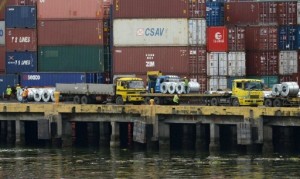
Shipping containers of Philippine products for export sit stacked along the docks of the international container port in Manila on Sept. 11, 2012. Exports climbed 16.5 percent in December to $3.97 billion, the biggest rise in three months. AFP PHOTO/JAY DIRECTO
Exports climbed 16.5 percent in December to $3.97 billion, the biggest rise in three months, helped by sales of tropical fruits and some nontraditional items such as petroleum products, the National Statistics Office reported Tuesday.
However, electronics and semiconductor shipments contracted 5.5 percent in December from a year ago. For the entire 2012, shipments from the sector fell 5.2 percent against an industry forecast of flat exports from 2011.
Overall growth in exports in 2012 has been restrained, due largely to lackluster global demand for the country’s main semiconductors and electronics shipments. The latest data brought exports for the whole of 2012 to $52 billion, up 7.6 percent from a year ago.
Electronics made up nearly 38 percent of December export revenues, with woodcrafts and furniture as the second-biggest export item, comprising 4.9 percent of the total.
Exports to Japan, the country’s top export destination in December, were up 12.7 percent from a year earlier. Exports to the United States, the second-biggest market, dropped 5.9 percent from a year earlier. Shipments to China, the third-biggest market, were down 10.8 percent from a year ago. Eastern Asia— the top export destination by economic bloc, accounting for 48.7 percent of total shipments—rose 18.2 percent from a year earlier. Southeast Asia and the European Union were the second and third biggest economic blocs.
The export data “is going to lead to a possible upward revision of our already very good growth figure for 2012. This has not been factored in when the data was released last month. The non-electronics portion is quite encouraging and could mean that the weaker prints for November and the prior months were temporary,” said Emilio Neri, economist at Bank of the Philippine Islands.
“However, for the electronics sector, it is still a little bit worrisome because we are seeing significant rebounds elsewhere in the region and yet we seem to be lagging behind. It is an area of concern and should be studied closely, so that the appropriate policies can be put in place to address (the weakness),” he noted.
Economist Benjamin Diokno of the UP School of Economics said the annual growth was “unspectacular” as it was less than the adjusted growth target of 8 percent and the Development Budget Coordination Committee-approved export growth assumption of 10 percent. The original growth target was 12 percent.
Nevertheless, the Philippines’ export performance reflected the generally improved prospects in the global economy on the back of policy support implemented by major economies, most notably in the euro area, the United States and Japan, Economic Planning Secretary Arsenio M. Balisacan said in a statement. Balisacan is also director general of the National Economic and Development Authority (Neda).
Product diversification and expanded markets opened by free-trade agreements signed by the Philippines with countries such as Japan, Korea, China, Australia and New Zealand also helped boost outbound shipments, the Department of Trade and Industry said in a separate statement.
Neda said the Philippines posted the highest annual growth in merchandise exports in December 2012 among its trade-oriented neighbors in East and Southeast Asia. Other Asian economies that recorded positive export growth during the month were Hong Kong (14.8 percent), China (14.1 percent), Vietnam (14.1 percent), Thailand (13.5 percent) and Taiwan (9 percent). With a report from Reuters